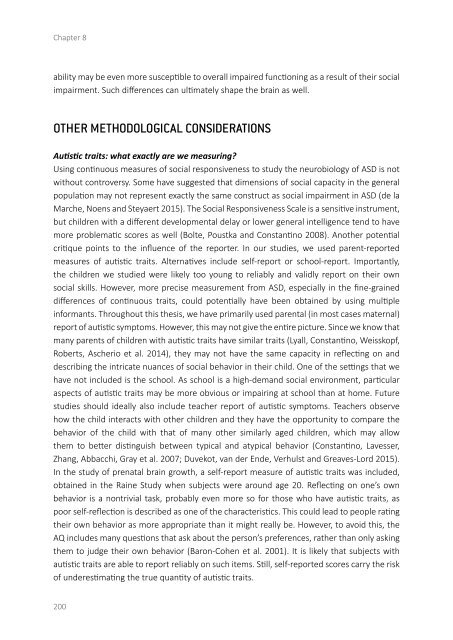On the Spectrum
2lm5UyR
2lm5UyR
You also want an ePaper? Increase the reach of your titles
YUMPU automatically turns print PDFs into web optimized ePapers that Google loves.
Chapter 8<br />
ability may be even more susceptible to overall impaired functioning as a result of <strong>the</strong>ir social<br />
impairment. Such differences can ultimately shape <strong>the</strong> brain as well.<br />
OTHER METHODOLOGICAL CONSIDERATIONS<br />
Autistic traits: what exactly are we measuring?<br />
Using continuous measures of social responsiveness to study <strong>the</strong> neurobiology of ASD is not<br />
without controversy. Some have suggested that dimensions of social capacity in <strong>the</strong> general<br />
population may not represent exactly <strong>the</strong> same construct as social impairment in ASD (de la<br />
Marche, Noens and Steyaert 2015). The Social Responsiveness Scale is a sensitive instrument,<br />
but children with a different developmental delay or lower general intelligence tend to have<br />
more problematic scores as well (Bolte, Poustka and Constantino 2008). Ano<strong>the</strong>r potential<br />
critique points to <strong>the</strong> influence of <strong>the</strong> reporter. In our studies, we used parent-reported<br />
measures of autistic traits. Alternatives include self-report or school-report. Importantly,<br />
<strong>the</strong> children we studied were likely too young to reliably and validly report on <strong>the</strong>ir own<br />
social skills. However, more precise measurement from ASD, especially in <strong>the</strong> fine-grained<br />
differences of continuous traits, could potentially have been obtained by using multiple<br />
informants. Throughout this <strong>the</strong>sis, we have primarily used parental (in most cases maternal)<br />
report of autistic symptoms. However, this may not give <strong>the</strong> entire picture. Since we know that<br />
many parents of children with autistic traits have similar traits (Lyall, Constantino, Weisskopf,<br />
Roberts, Ascherio et al. 2014), <strong>the</strong>y may not have <strong>the</strong> same capacity in reflecting on and<br />
describing <strong>the</strong> intricate nuances of social behavior in <strong>the</strong>ir child. <strong>On</strong>e of <strong>the</strong> settings that we<br />
have not included is <strong>the</strong> school. As school is a high-demand social environment, particular<br />
aspects of autistic traits may be more obvious or impairing at school than at home. Future<br />
studies should ideally also include teacher report of autistic symptoms. Teachers observe<br />
how <strong>the</strong> child interacts with o<strong>the</strong>r children and <strong>the</strong>y have <strong>the</strong> opportunity to compare <strong>the</strong><br />
behavior of <strong>the</strong> child with that of many o<strong>the</strong>r similarly aged children, which may allow<br />
<strong>the</strong>m to better distinguish between typical and atypical behavior (Constantino, Lavesser,<br />
Zhang, Abbacchi, Gray et al. 2007; Duvekot, van der Ende, Verhulst and Greaves-Lord 2015).<br />
In <strong>the</strong> study of prenatal brain growth, a self-report measure of autistic traits was included,<br />
obtained in <strong>the</strong> Raine Study when subjects were around age 20. Reflecting on one’s own<br />
behavior is a nontrivial task, probably even more so for those who have autistic traits, as<br />
poor self-reflection is described as one of <strong>the</strong> characteristics. This could lead to people rating<br />
<strong>the</strong>ir own behavior as more appropriate than it might really be. However, to avoid this, <strong>the</strong><br />
AQ includes many questions that ask about <strong>the</strong> person’s preferences, ra<strong>the</strong>r than only asking<br />
<strong>the</strong>m to judge <strong>the</strong>ir own behavior (Baron-Cohen et al. 2001). It is likely that subjects with<br />
autistic traits are able to report reliably on such items. Still, self-reported scores carry <strong>the</strong> risk<br />
of underestimating <strong>the</strong> true quantity of autistic traits.<br />
200


